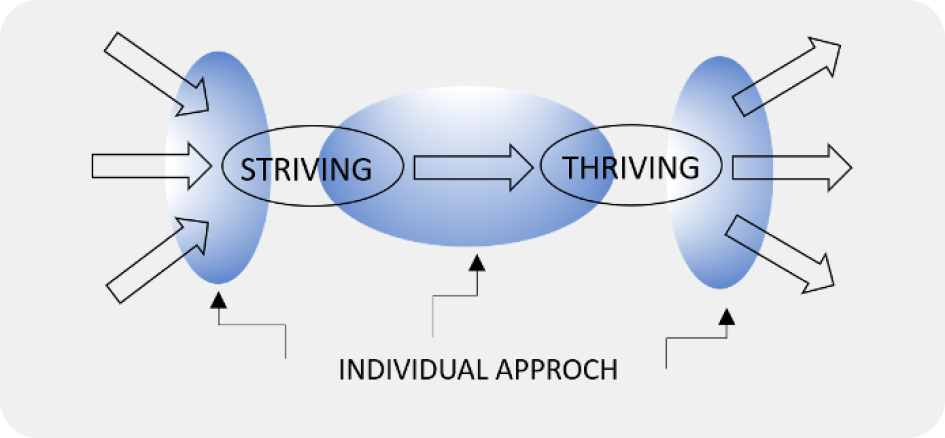In the design process, every designer follows a similar journey from striving to thriving. Beginning with the intake of diverse data and the identification of problems, and ending with the formulation of solutions and outputs, striving and thriving flow together as an interrelated dual system.
Striving can be thought of as an import process, in which designers accumulate and sort information, knowledge, issues, agendas, and conflicts. During this phase, all variables nurture the designer’s process of thinking, acting and developing. The process then evolves through various stages into one of thriving. Thriving is more an export process in which solutions, ideas, initiatives, and prototypes are shared with the world. Individual differences weave into the entire process, impacting the way a designer addresses complex problems and solutions, and the way they share their explorations with the world.
The relationship between striving and thriving can be analyzed through three differing approaches to the design process. Each approach is based on a designer’s individual preference, with several behavioral characteristics influencing a designer’s problem identification and solution development differently.
1. Personal Approach. This approach focuses on the process itself and the designer’s distinctly personal method of idea generation. It is based on rich vocabulary and resources of analogies and leverages the individual’s thinking style and strengths. Personal approach designers excel in self-monitoring, resulting in an exceptional understanding of the use of tools and strategic knowledge.
2. Information Driven Approach. This approach focuses on an in depth analysis of problems through research, in-domain knowledge, and a large body of ideas. Information driven approach designers are exceptional in the analysis of data and have great sensitivity in monitoring the progress of complex processes.
3. Realistic Approach. This approach focuses on implementing solutions in complex situations through evidence-based awareness. Realistic approach designers excel at using professional case studies to benefit the implementation of solutions. They put emphasis on examining the quality of solutions based on objective knowledge and details.
These individual approaches act as filters at three crucial points within the design process. The first point influences how the import process translates to striving. The second point represents the progression from striving to thriving, and the third point is the export process of sharing through thriving. Diagram 1 shows this process as a dual interrelated system.

Diagram 1: From striving to thriving – an interrelated dual system
These differences can be identified by analyzing designers’ preferred behavioral characteristics as they engage in the creative process of problem formulation and solution generation. For example, problem formulation is influenced by the way a designer frames the problem and the personal resources that are used in the process. Alternatively, solution generation takes into account the thinking process, the use of examples, and the assessment used.
The three general approaches represent the diversity of personal journeys in a design process from striving to thriving. In each case, however the quality of designing thriving depends on the level of trust in the design process. “Trust” is the most critical component for success. Individual designers can cultivate trust by understanding and staying true to their personal process journey. Stakeholders who depend on the designer, such as the community, company, or academic system can also cultivate a sense of trust by understanding and recognizing the individual difference of each designer.
The relevancy of a designer’s individual differences and unique process journeys relate to both the academic world and the profession. If professors identify a designers’ preferred approach early, they can personalize the various methods of teaching that are suited for that specific journey. Similarly, organizations can assign projects to individuals and teams that match the right approach to the right situation. Being actively conscious of designers’ journeys will allow for the process of designing thriving to reach its highest quality and potential.
Sources
Bar-Eli, S. (2010). Design behavior profiles: similarities and differences in design students' processes, Saarbrucke, Germany: LAMBERT Academic Publishing.
Bar-Eli, S. (2013). Sketching Profiles: awareness to individual differences in sketching as means of enhancing design solution development. Design studies, 34 (4), 472-493.




